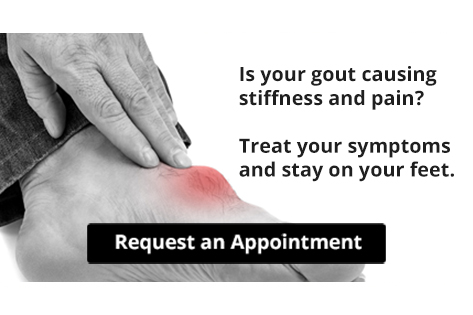Connect With Us
Blog
Items filtered by date: September 2025
Understanding Flat Feet in Children and When to Seek Help
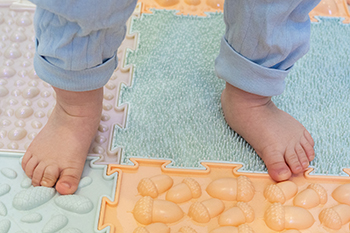
Flat feet in children occur when the arches of the feet do not develop properly, causing the entire sole to touch the ground. It may look like the child has no visible arch and their ankles may appear to roll inward. While many children experience no pain, some may complain of foot, ankle, or leg discomfort, especially after physical activity. Causes include genetics, loose ligaments, or underlying conditions like cerebral palsy. Symptoms may also include fatigue, poor balance, or difficulty with walking or playing sports. A podiatrist can diagnose flat feet through a physical examination and imaging tests if needed. Treatment options vary based on severity and symptoms and may include custom orthotics, supportive footwear, or stretching exercises. In rare cases, surgery may be considered. Early evaluation can prevent long-term complications and improve a child’s comfort and mobility. If you notice signs of flat feet in your child, it is suggested that you make an appointment with a podiatrist.
Flatfoot is a condition many people suffer from. If you have flat feet, contact Rahil Baxamusa, DPM from Illinois. Our doctor will treat your foot and ankle needs.
What Are Flat Feet?
Flatfoot is a condition in which the arch of the foot is depressed and the sole of the foot is almost completely in contact with the ground. About 20-30% of the population generally has flat feet because their arches never formed during growth.
Conditions & Problems:
Having flat feet makes it difficult to run or walk because of the stress placed on the ankles.
Alignment – The general alignment of your legs can be disrupted, because the ankles move inward which can cause major discomfort.
Knees – If you have complications with your knees, flat feet can be a contributor to arthritis in that area.
Symptoms
- Pain around the heel or arch area
- Trouble standing on the tip toe
- Swelling around the inside of the ankle
- Flat look to one or both feet
- Having your shoes feel uneven when worn
Treatment
If you are experiencing pain and stress on the foot you may weaken the posterior tibial tendon, which runs around the inside of the ankle.
If you have any questions, please feel free to contact our office located in Crystal Lake, IL . We offer the newest diagnostic and treatment technologies for all your foot care needs.
Tips to Help Prevent Running Injuries
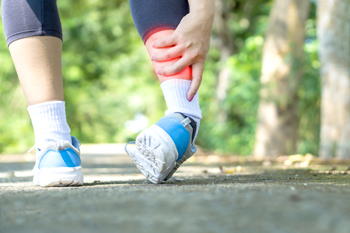 Did you know that 80% of running injuries are caused by repetitive stress? Sudden injuries can occur too, such as torn muscles or sprained ankles. Luckily, there are steps that you can take to help prevent running injuries. Before you start your run, it is suggested that you warm up for 5-10 minutes by doing an easy jog or dynamic mobility stretches, like swinging your legs. When you are running, slowly increase the time and distance that you run. If possible, run on a soft surface like grass or sand. These soft surfaces are generally easier on your joints as opposed to running on the pavement. If you do sustain an injury, seek treatment right away and be sure to give your body adequate rest. Running with an injury could make the condition worse or cause new injuries to develop. For more information on how to prevent running injuries, consult with a podiatrist.
Did you know that 80% of running injuries are caused by repetitive stress? Sudden injuries can occur too, such as torn muscles or sprained ankles. Luckily, there are steps that you can take to help prevent running injuries. Before you start your run, it is suggested that you warm up for 5-10 minutes by doing an easy jog or dynamic mobility stretches, like swinging your legs. When you are running, slowly increase the time and distance that you run. If possible, run on a soft surface like grass or sand. These soft surfaces are generally easier on your joints as opposed to running on the pavement. If you do sustain an injury, seek treatment right away and be sure to give your body adequate rest. Running with an injury could make the condition worse or cause new injuries to develop. For more information on how to prevent running injuries, consult with a podiatrist.
Exercising your feet regularly with the proper foot wear is a great way to prevent injuries. If you have any concerns about your feet, contact Rahil Baxamusa, DPM of Illinois. Our doctor will treat your foot and ankle needs.
How to Prevent Running Injuries
Many common running injuries are caused by overuse and overtraining. When the back of the kneecap starts wearing out and starts causing pain in your knee, this is commonly referred to as runner’s knee. Runner’s knee is a decrease in strength in your quadriceps and can occur if you’re not wearing properly fitted or supporting shoes. To prevent runner’s knee, focusing on hip strengthening is a good idea, as well as strengthening your quads to keep the kneecaps aligned.
What Are Some Causes of Running Injuries?
- One cause of a common running injury is called iliotibial band syndrome.
- Plantar fasciitis is also another common injury.
- Stress fractures can occur from overtraining, lack of calcium, or even your running style.
Best Ways to Prevent Running Injuries
- Wear footwear that fits properly and suits your running needs.
- Running shoes are the only protective gear that runners have to safeguard them from injury.
- Make a training schedule. Adding strengthening exercises as well as regular stretching can help keep you strong and limber and can lessen the possibility of injuries.
- Stretching keeps muscles limber; this will help you gain better flexibility.
If you have any questions, please feel free to contact our office located in Crystal Lake, IL . We offer the newest diagnostic and treatment technologies for all your foot care needs.
Bunion Causes and Symptoms
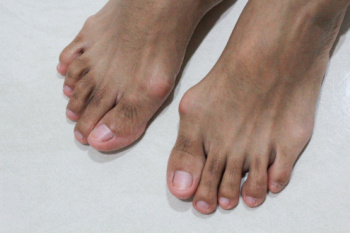
Bunions are a foot deformity that often develop gradually, leading to pain and changes in toe alignment. The most noticeable symptom of a bunion is a hard, bony bump on the side of the big toe that may become red, swollen, and tender from pressure inside shoes. As the bunion progresses, the big toe shifts inward toward the second toe, sometimes crossing over or under it, which can cause stiffness and difficulty in moving the joint. Pain at the base of the toe is common, especially when walking or standing for long periods. Bunions may also lead to irritation of the bursa, a small fluid-filled sac, resulting in bursitis, or displacement of the sesamoid bones under the big toe joint. Causes of bunions include inherited foot structure, arthritis, and frequent use of shoes that lack adequate support or have a narrow, pointed toe box, such as high heels or flip-flops. If you are experiencing pain from a bunion, it is suggested that you schedule an appointment with a podiatrist for an evaluation and appropriate treatment.
If you are suffering from bunion pain, contact Rahil Baxamusa, DPM of Illinois. Our doctor can provide the care you need to keep you pain-free and on your feet.
What Is a Bunion?
Bunions are painful bony bumps that usually develop on the inside of the foot at the joint of the big toe. As the deformity increases over time, it may become painful to walk and wear shoes. Women are more likely to exacerbate existing bunions since they often wear tight, narrow shoes that shift their toes together. Bunion pain can be relieved by wearing wider shoes with enough room for the toes.
Causes
- Genetics – some people inherit feet that are more prone to bunion development
- Inflammatory Conditions - rheumatoid arthritis and polio may cause bunion development
Symptoms
- Redness and inflammation
- Pain and tenderness
- Callus or corns on the bump
- Restricted motion in the big toe
In order to diagnose your bunion, your podiatrist may ask about your medical history, symptoms, and general health. Your doctor might also order an x-ray to take a closer look at your feet. Nonsurgical treatment options include orthotics, padding, icing, changes in footwear, and medication. If nonsurgical treatments don’t alleviate your bunion pain, surgery may be necessary.
If you have any questions, please feel free to contact our office located in Crystal Lake, IL . We offer the newest diagnostic and treatment technologies for all your foot care needs.
Gout Pain Can Be Managed
Understanding Kohler Disease in Children
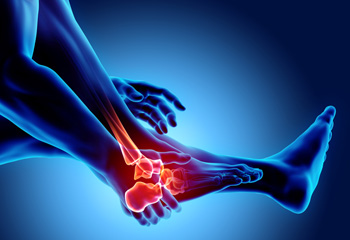
Kohler disease is a rare foot condition that affects the tarsal navicular bone. This small midfoot bone helps connect the ankle to the toes and supports the arch, which becomes compressed and weakened. Kohler disease typically occurs in children between the ages of five and 10. The exact cause is unknown, but possible genetic links and disruptions in blood supply may contribute. Symptoms often include redness of the foot, tenderness along the length of the arch, swelling, and limping due to pain. Although the condition usually resolves with time, early diagnosis is important to relieve discomfort and prevent long-term issues. A podiatrist can provide supportive treatments, recommend protective footwear, and monitor healing. If your child shows signs of Kohler disease or has foot pain of any kind, it is suggested that you promptly consult a podiatrist to schedule an appointment for expert care.
Some foot conditions may require additional professional care. If you have any concerns, contact Rahil Baxamusa, DPM of Illinois. Our doctor can provide the care you need to keep you pain-free and on your feet.
Rare Foot Conditions
The majority of foot conditions are common and can be treated by a podiatrist. Standard diagnostic procedures are generally used to identify specific conditions and treatment can be rendered. A podiatrist also treats rare foot conditions which can be difficult to diagnose and may need extra attention and care.
There are many rare foot conditions that can affect children. Some of these can include:
- Freiberg’s disease
- Kohler’s disease
- Maffucci syndrome
Freiberg’s disease - This can be seen as a deterioration and flattening of a metatarsal bone that exists in the ball of the foot. It typically affects pre-teen and teenage girls, but can affect anyone at any age. Symptoms that can accompany this can be swelling, stiffness, and the patient may limp.
Kohler’s disease - This often targets the bone in the arch of the foot and affects younger boys. It can lead to an interruption of the blood supply which ultimately can lead to bone deterioration. The patient may limp or experience tenderness, swelling, and redness.
Maffucci syndrome - This affects the long bones in a child’s foot leading to the development of abnormal bone lesions. They are benign growths and typically develop in early childhood and the bones may be susceptible to breaking.
A podiatrist can properly diagnose and treat all types of rare foot conditions. If your child is affected by any of these symptoms or conditions, please don’t hesitate to call our office so the correct treatment method can begin.
If you have any questions, please feel free to contact our office located in Crystal Lake, IL . We offer the newest diagnostic and treatment technologies for all your foot care needs.
Cracked Heels and Who Is Most at Risk
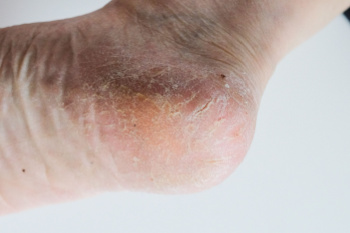
Heel fissures, often called cracked heels, occur when the skin surrounding the heel becomes dry, thickened, and splits open. They are not only uncomfortable but can also become painful and prone to infection, if left untreated. People who stand for long hours of time, wear open-backed shoes, or live in dry climates are more likely to develop them. Seniors, individuals with diabetes, and those with skin conditions such as eczema or psoriasis, are also at greater risk. Treatment begins with softening the skin through regular moisturizing and gentle exfoliation. Thick emollients or heel balms can help seal in moisture and protect the skin. Wearing supportive shoes with a closed back reduces pressure and prevents further cracking. If you have severe heel fissures, it is suggested that you see a podiatrist who may remove thickened skin or provide specialized treatments before complications develop.
Cracked heels are unsightly and can cause further damage to your shoes and feet. If you have any concerns, contact Rahil Baxamusa, DPM from Illinois. Our doctor can provide the care you need to keep you pain-free and on your feet.
Cracked Heels
Cracked heels appear unappealing and can make it harder for you walk around in sandals. Aside from looking unpleasant, cracked heels can also tear stockings, socks, and wear out your shoes. There are several methods to help restore a cracked heel and prevent further damage.
How Do You Get Them?
Dry skin is the number one culprit in creating cracked heels. Many athletes, walkers, joggers, and even swimmers suffer from cracked heels. Age and skin oil production play a role to getting cracked heels as well.
Promote Healing
Over the counter medicines can help, especially for those that need instant relief or who suffer from chronic dry feet.
Wear Socks – Wearing socks with medicated creams helps lock in moisture.
Moisturizers – Applying both day and night will help alleviate dryness which causes cracking.
Pumice Stones – These exfoliate and remove dead skin, which allows for smoother moisturizer application and better absorption into the skin.
Change in Diet
Eating healthy with a well-balanced diet will give the skin a fresh and radiant look. Your body responds to the kinds of food you ingest. Omega-3 fatty acids and zinc supplements can also revitalize skin tissue.
Most importantly, seek professional help if unsure how to proceed in treating cracked heels. A podiatrist will help you with any questions or information needed.
If you have any questions, please feel free to contact our office located in Crystal Lake, IL . We offer the newest diagnostic and treatment technologies for all your foot care needs.
Blog Archives
- October 2025
- September 2025
- August 2025
- July 2025
- June 2025
- May 2025
- April 2025
- March 2025
- February 2025
- January 2025
- December 2024
- November 2024
- October 2024
- September 2024
- August 2024
- July 2024
- June 2024
- May 2024
- April 2024
- March 2024
- February 2024
- January 2024
- December 2023
- November 2023
- October 2023
- September 2023
- August 2023
- July 2023
- June 2023
- May 2023
- April 2023
- March 2023
- February 2023
- January 2023
- December 2022
- November 2022
- October 2022
- September 2022
- August 2022
- July 2022
- June 2022
- May 2022
